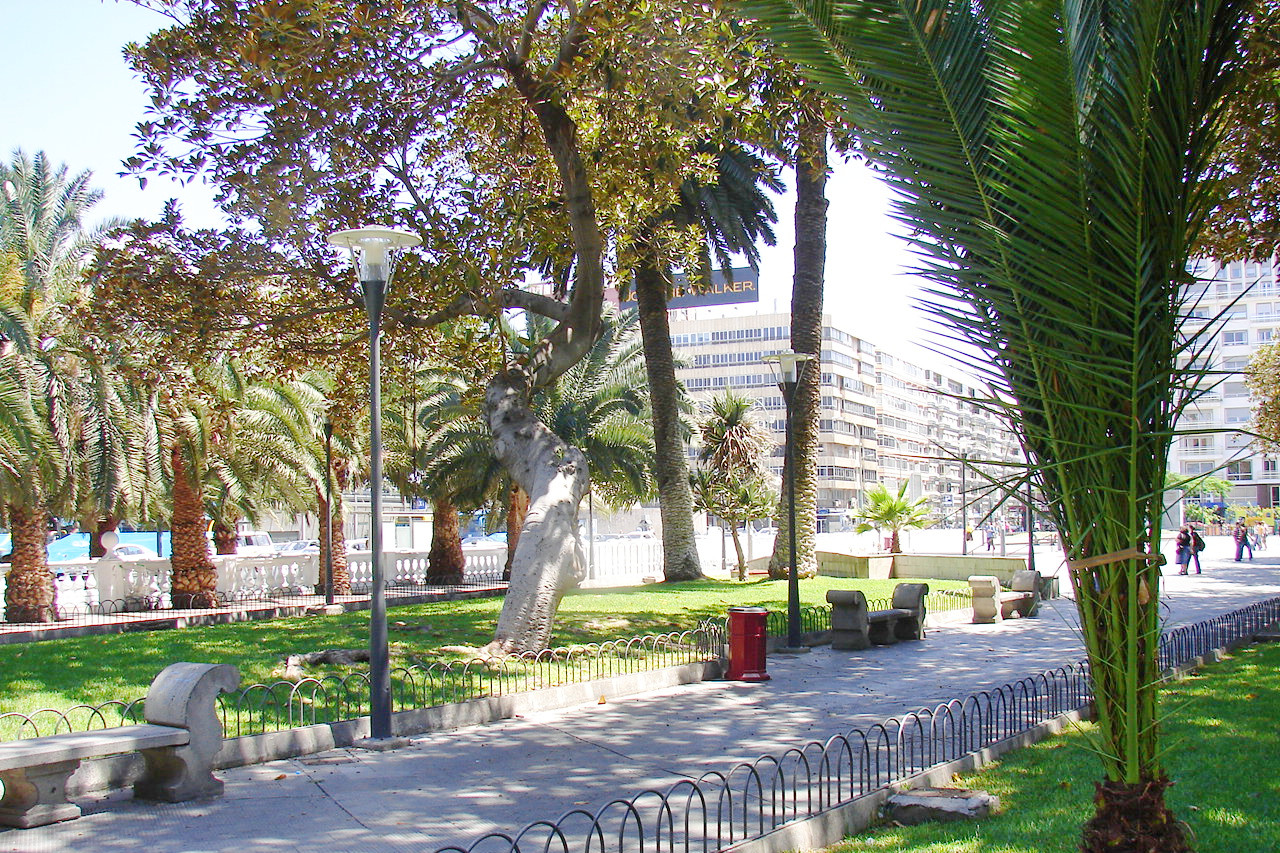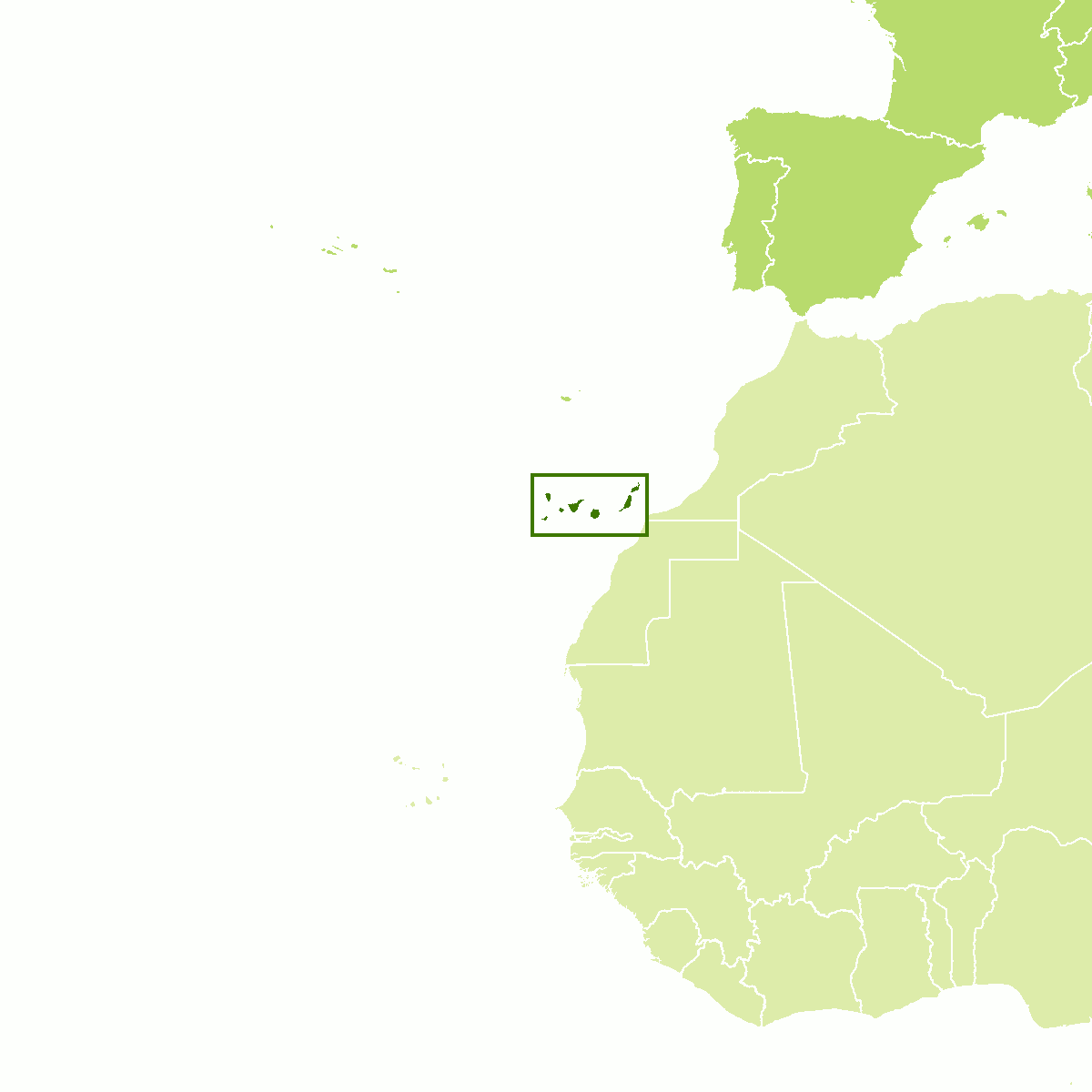The Climate of the
Canary Islands
 Parque de San Telmo, Las Palmas
Parque de San Telmo, Las Palmas
Climate Map
 Climate map of the Canary Islands
Climate map of the Canary Islands
What is the climate of the Canary Islands like?
The Canary Islands form an archipelago of seven main islands, situated in about latitude 28°N, some 100 km/60 mi off the Moroccan coast of North Africa. Administratively the islands are an integral part of Spain, having been occupied by Spain in the 15th century. They are rugged volcanic islands with the highest peak, on the island of Tenerife, rising to 3,700 meters (12,200 feet). This high mountain is snow-capped in winter, in marked contrast to the mild winter temperatures experienced at or near sea level. The waters of the Atlantic Ocean are here rather cool because of the cold Canaries current; thus, summer temperatures rarely rise very high, while winters are mild.
The Canary Islands have a tropical climate. In January, the coldest month, the temperature at sea-level typically ranges from 19 to 23°C (66 to 73°F) during the day, and around 15 to 16°C (59 to 61°F) at night. In the warmest months–August and September–the temperature typically ranges from 27 to 30°C (81 to 86°F) during the day, above 21°C (70°F) at night. Large fluctuations in temperature are rare.
The warmest days in summer occur when hot, dry air is drawn out from the Sahara desert and reaches as far as the islands. This air may sometimes be laden with fine dust particles blown from the desert. However, it reaches the islands with a raised relative humidity and lower temperatures after its passage across the cool ocean water. Even in winter the islands are occasionally visited by this hot African wind.
The weather may be disturbed for a few days at a time in winter under the influence of an Atlantic depression, but such stormy and wet periods are not frequent. Summer months are usually dry and sunny with no very hot days. However some fog and cloud may occur when a north or northeast wind blows upon the islands. In summer this wind can produce dense clouds.
On the southwest coasts there is no regular sea or land breeze. The sheltered southern coast tend to have semi-arid, or even desert conditions with low rainfall. The northern shores of the islands, being more exposed to the predominant northeast trade winds, are rather wetter. The inland parts of the western islands of La Gomera, Tenerife and La Palma have a more humid, subtropical climate, where laurisilva cloud forests grow. Daily sunshine hours range from an average of six in winter to as many as eleven in the summer months.
Las Palmas is representative of conditions at or near sea level.
| Climate data for Las Palmas (1981–2010) | |||||||||||||
|---|---|---|---|---|---|---|---|---|---|---|---|---|---|
| Month | Jan | Feb | Mar | Apr | May | Jun | Jul | Aug | Sep | Oct | Nov | Dec | Year |
| Average high °C (°F) | 20.8 (69.4) | 21.2 (70.2) | 22.3 (72.1) | 22.6 (72.7) | 23.6 (74.5) | 25.3 (77.5) | 26.9 (80.4) | 27.5 (81.5) | 27.2 (81.0) | 26.2 (79.2) | 24.2 (75.6) | 22.2 (72.0) | 24.2 (75.6) |
| Daily mean °C (°F) | 18.1 (64.6) | 18.4 (65.1) | 19.3 (66.7) | 19.5 (67.1) | 20.5 (68.9) | 22.2 (72.0) | 23.8 (74.8) | 24.6 (76.3) | 24.3 (75.7) | 23.1 (73.6) | 21.2 (70.2) | 19.3 (66.7) | 21.2 (70.2) |
| Average low °C (°F) | 15.3 (59.5) | 15.6 (60.1) | 16.2 (61.2) | 16.3 (61.3) | 17.3 (63.1) | 19.2 (66.6) | 20.8 (69.4) | 21.6 (70.9) | 21.4 (70.5) | 20.1 (68.2) | 18.1 (64.6) | 16.5 (61.7) | 18.2 (64.8) |
| Average precipitation mm (inches) | 25.1 (0.99) | 24.4 (0.96) | 12.5 (0.49) | 5.9 (0.23) | 1.1 (0.04) | 0.3 (0.01) | 0.1 (0.00) | 0.4 (0.02) | 9.1 (0.36) | 16.0 (0.63) | 22.4 (0.88) | 31.3 (1.23) | 151.3 (5.96) |
| Source: World Meteorological Organization | |||||||||||||
References
- E. A. Pearce, Charles Gordon Smith, (1990) The Hutchinson World Weather Guide, John Murray Press. ISBN 1859863426
- Timothy L. Gall, (ed.), (2003), Worldmark Encyclopedia of the Nations, Eleventh Edition, Thomson Gale
- Hugh Chisholm, (ed.), (1911), Encyclopædia Britannica, Eleventh edition, Cambridge University Press
The Climate of the
Canary Islands

In summary:
The Canary Islands have a tropical climate, moderated by the sea and in summer by the trade winds. Average temperatures at Las Palmas range from 24°C (75°F) in January to 18°C (65°F) in July.
Rainfall is low at sea-level especially on the sheltered southern coasts, but the climate is more humid in the mountains.